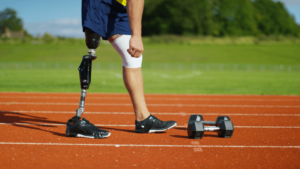
There are different types of prosthetic legs available depending on the level of amputation and individual needs and abilities. For lower limb amputations, the main types include:
– Transtibial (below the knee) prosthesis: This is the most common type for those who have had a leg amputated below the knee. It consists of a socket that fits around the remaining part of the leg and ankle mechanism attached to a foot component. Materials used can range from basic plastic and rubber to more advanced carbon fiber and microprocessor controlled joints.
– Transfemoral (above the knee) prosthesis: For higher amputations, a prosthetic leg includes a socket that fits around the remaining thigh bone. It has a knee and ankle mechanism with a foot attachment. Construction involves rigid materials like aluminum or flexible composite plastics. Some include microprocessor controlled “smart” knees for more natural movement.
– Hip disarticulation or transfemoral (through the hip): For those who have had an amputation through the hip joint or higher, a prosthetic leg is attached directly to the pelvis. It generally has an above-knee socket, computerized knee and ankle-foot mechanism.
Materials and Components
Prosthetic leg designs have evolved significantly in recent decades due to advances in materials science and computer technology. Lightweight, high-strength materials like carbon fiber, titanium and high-performance plastics are now commonly used.
Socket designs have also improved to evenly distribute pressure and prevent discomfort. Suspension methods include pin and lock systems, vacuum sealing and supracondylar (above knee) suspensions. Prosthetic feet available include flexible ‘energy storing’ feet and more life-like microprocessor controlled ‘smart’ feet that mimic the ankle joint. Computerized ‘smart’ knees that can sense changes in terrain and automatically adjust are also available.
Benefits of Prosthetic Legs
Modern prosthetic legs provide numerous benefits compared to older designs. They allow those with limb loss to regain mobility, independence and an improved quality of life in many ways:
– Enhanced mobility and activities: Advanced prosthetic leg components permit walking, jogging, hiking and other physical activities that weren’t as feasible in the past. Some even provide functionalities like bending the knees to sit.
– Increased convenience and comfort: Lightweight carbon fiber and high-performance plastics make prosthetics less tiring to use. vacuum and suspension systems ensure a secure, comfortable fit.
– Cosmetic realism: Life-like prosthetic coverings and feet can help amputees blend in and participate socially without drawing extra attention to their prosthesis.
– Occupational rehabilitation: With proper training and advanced prosthetics, many amputees are able resume or continue their careers and hobbies without limitations. This provides economic empowerment and a sense of normalcy.
Treatment and Manufacturing Process
The process of obtaining a prosthetic leg generally involves several steps:
– Evaluation by a physiatrist or prosthetist: Assessment of medical history, residual limb, lifestyle needs and functional goals takes place. Plaster casts may be taken.
– Socket fabrication: Using 3D scanning, plaster molds or direct molding, a custom-fitted suspension socket is made from rigid materials to surround the residual limb.
– Component assembly: Feet, ankles, knees and other mechanisms are selected based on evaluation. They are attached to the socket to complete assembly.
– Prosthetic fitting: At this stage, adjustments are made for comfort, gait and usability. Additional fittings occur to account for limb volume changes.
– Training and rehabilitation: Under guidance, patients learn proper donning/doffing techniques and how to maneuver with their new prosthesis. Gait re-education establishes stability and confidence.
– Periodic maintenance and replacement: Prosthetics require occasional servicing. As tissue or activity levels change, modification or entirely new prostheses may become necessary every few years on average.
Research advances Prosthetic Leg design and functionality. Modern production includes 3D printing, CAD/CAM modeling and rapid prototyping which speeds manufacturing and permits customization. Ongoing R&D aims to develop even more biomechanically efficient and intelligent prosthetics for improved user experience and independence.
In conclusion, through the dedicated work of medical professionals, engineers and manufacturers, today’s prosthetic leg technologies are restoring functionality and empowering those with limb loss to live full, active lives. Continuing innovation promises further enhancements to mobility and quality of living for amputees in the future.
*Note:
1. Source: Coherent Market Insights, Public sources, Desk research
2. We have leveraged AI tools to mine information and compile it

